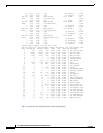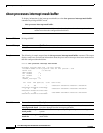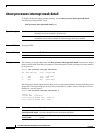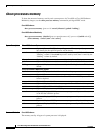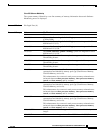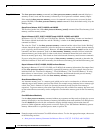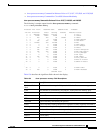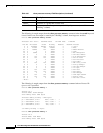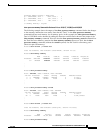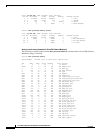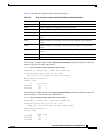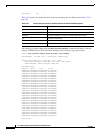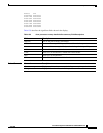
show processes memory
CF-850
Cisco IOS Configuration Fundamentals Command Reference
July 2008
Usage Guidelines The show processes memory command (and show processes memory sorted command) displays a
summary of total, used, and free memory, followed by a list of processes and their memory impact.
If the standard show processes memory process-id command is used, processes are sorted by their
process ID (PID). If the show processes memory sorted command is used, the default sorting is by the
Holding value.
Output Prior to Releases 12.3(7)T, 12.2(22)S, and 12.0(28)S
The first line (header line) of the show processes memory [sorted] command listed Total memory, Used
memory, and Free memory values.
Output in Releases 12.3(7)T, 12.3(8)T, 12.2(22)S Through 12.2(27)S2, 12.0(28)S, and 12.0(29)S
In Releases 12.3(7)T, 12.2(22)S, and 12.0(28)S, the “Memory Thresholding” feature was introduced.
This feature affected the header line and the “Holding” column of the show processes memory
command as follows.
The value for “Total” in the show processes memory command and the values listed in the “Holding”
column, showed the total (cumulative) value for the processor memory pools and the alternate memory
pool* (typically, the I/O memory pool). However, the show processes memory sorted version of this
command, and other commands, such as the show memory summary command, did not include the
alternate memory pool in the totals (in other words, these commands showed the total value for the
Processor memory pool only). This caused an observed mismatch of memory totals between commands.
If you are using these releases, use the output of show memory summary command to determine the
individual amounts of Total and Free memory for the Processor memory pool and the I/O memory pool.
Output in Releases 12.3(11)T, 12.2(28)S, 12.0(30)S and Later Releases
Beginning in Releases 12.3(11)T, 12.2(28)S, and 12.0(30)S, the summary information (first output lines)
for the show processes memory command is separated by memory pool. For example, there are now
individual lines for “Total Process Memory,” “Total I/O Memory,” and “Total PCI Memory.” If using
these releases or later releases, your Total Process Memory should match the total process memory
shown for other commands, such as the show memory summary command.
About Alternate Memory Pools
An “alternate memory pool” is a memory pool which can be used as an alternative to allocate memory
when the target (main) memory pool has been filled. For example, many platforms have a memory type
called “Fast” that is limited to a small size (because the memory media used for Fast memory is
expensive). To prevent memory allocations from failing once the available Fast memory has been used
up, the normal Processor memory can be configured as an alternative memory pool for the Fast memory
pool.
Cisco IOS Software Modularity
Use the show processes memory command without any arguments and keywords to display the system
memory followed by a one-line summary of memory information about each modular Cisco IOS process.
Use the detailed keyword with this command to display detailed memory information about all
processes. Other arguments and keywords are used to display Cisco IOS Software Modularity process
memory information for a specified process name or process ID.
Examples Example output varies between Cisco IOS software releases. To view the appropriate output, choose one
of the following sections:
• show processes memory Command for Releases Prior to 12.3(7)T, 12.2(22)S, and 12.0(28)S



